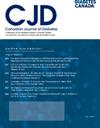内分泌学家对成人1型糖尿病患者糖化血红蛋白指标的接受度和实施
IF 2.3
4区 医学
Q3 ENDOCRINOLOGY & METABOLISM
引用次数: 0
摘要
目的:在1型糖尿病(T1D)患者中,A1C≤7.0%的达标率一直很低。我们评估了内分泌学家对A1C指标的可接受性和执行情况。方法:在2023年10月31日至2024年1月16日期间,安大略省所有309名成年内分泌学家被邀请完成一份在线问卷。问卷由四个部分组成:1)糖化血红蛋白目标≤7.0%的可接受性,通过与可接受性理论框架(TFA)的七个领域相关的陈述进行评估;2)内分泌科医师对患者A1C达标的认知、设定和讨论A1C达标的频率、常用的A1C达标指标、关于A1C达标的开放式问题;3)不同患者特征对选择个体化A1C目标的影响(7.0%);4)被调查者特征。结果:148名内分泌科医师(48%)完成问卷调查。内分泌学家认为A1C≤7.0%的目标是重要的(87%同意或强烈同意)和正确的阈值(75%同意或强烈同意)。结论:内分泌科医师认可≤7.0%的A1C目标,但同时对其可行性表示担忧。未来的研究应该评估这种差异如何影响医生讨论和咨询A1C目标。本文章由计算机程序翻译,如有差异,请以英文原文为准。
Endocrinologists’ Acceptability and Implementation of Glycated Hemoglobin Targets Among Adults With Type 1 Diabetes
Objectives
Attainment of the glycated hemoglobin (A1C) target of ≤7.0% is consistently low among those living with type 1 diabetes. We evaluated endocrinologists’ acceptability and implementation of A1C targets.
Methods
All 309 adult endocrinologists in Ontario were invited to complete an online questionnaire between October 31, 2023, and January 16, 2024. The questionnaire consisted of 4 sections: 1) acceptability of the A1C target of ≤7.0%, evaluated by agreement with statements pertaining to the 7 domains of the Theoretical Framework of Acceptability; 2) endocrinologists' perceptions of patient attainment of A1C targets, frequency of setting and discussing A1C targets, common targets used, and open-ended questions regarding A1C targets; 3) influence of patients’ characteristics on selecting individualized A1C targets different from 7.0%; and 4) respondents’ characteristics.
Results
One hundred forty-eight endocrinologists (48%) completed the questionnaire. Endocrinologists agreed that the A1C target of ≤7.0% is important (87% agreed or strongly agreed) and the correct threshold (75% agreed or strongly agreed). However, endocrinologists overestimated A1C target attainment among their own patients and recognized that the A1C target of <7.0% may be unrealistic for patients, difficult to achieve, and could cause patient distress. Patients’ psychosocial characteristics (such as mental health disorders) and use of technologies (such as continuous glucose monitors and automated insulin delivery systems) emerged as important, yet previously underemphasized, factors when selecting individualized A1C targets.
Conclusions
Endocrinologists endorsed the A1C target of ≤7.0%, but simultaneously expressed concerns regarding its feasibility. Future studies should evaluate how this discrepancy may impact physician discussions and counselling regarding A1C targets.
求助全文
通过发布文献求助,成功后即可免费获取论文全文。
去求助
来源期刊

Canadian Journal of Diabetes
ENDOCRINOLOGY & METABOLISM-
CiteScore
4.80
自引率
4.00%
发文量
130
审稿时长
54 days
期刊介绍:
The Canadian Journal of Diabetes is Canada''s only diabetes-oriented, peer-reviewed, interdisciplinary journal for diabetes health-care professionals.
Published bimonthly, the Canadian Journal of Diabetes contains original articles; reviews; case reports; shorter articles such as Perspectives in Practice, Practical Diabetes and Innovations in Diabetes Care; Diabetes Dilemmas and Letters to the Editor.
 求助内容:
求助内容: 应助结果提醒方式:
应助结果提醒方式:


